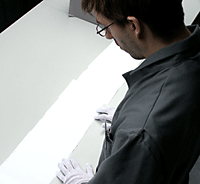Whitest Paper not Necessarily the Whitest
The most bleached paper is not always perceived as the whitest. New models provide paper producers with greater opportunities to measure how a piece of paper is perceived in real lighting environments, according to new research conducted by Innventia's Ludovic Coppel Gustafsson in Sweden. This, in turn, opens opportunities for optimized use of brighteners and more competitive products Gustafsson defended his licentiate dissertation "Whiteness and Fluorescence in Paper—Perception and Optical Modeling" this week at Mid Sweden University in Sundsvall.
Gustafsson's thesis is about modeling and predicting the perceived whiteness of plain paper from the paper composition, including fluorescent whitening agents. This includes psycho-physical modeling of perceived whiteness from measurable light reflectance properties, and physical modeling of light scattering and fluorescence from the paper composition.
 Existing models are first tested and improvements are suggested and evaluated. The standardized and widely used CIE whiteness equation is first tested on commercial office papers with visual evaluations by different panels of observers, and improved models are validated. Simultaneous contrast effects, known to affect the appearance of colored surfaces depending on the surrounding color, are shown to significantly affect the perceived whiteness. A color appearance model, including simultaneous contrast effects (CIECAM02-m2), earlier tested on colored surfaces, is successfully applied to perceived whiteness. A recently proposed extension of the Kubelka-Munk light scattering model including fluorescence for turbid media of finite thickness is successfully tested for the first time on real papers.
Existing models are first tested and improvements are suggested and evaluated. The standardized and widely used CIE whiteness equation is first tested on commercial office papers with visual evaluations by different panels of observers, and improved models are validated. Simultaneous contrast effects, known to affect the appearance of colored surfaces depending on the surrounding color, are shown to significantly affect the perceived whiteness. A color appearance model, including simultaneous contrast effects (CIECAM02-m2), earlier tested on colored surfaces, is successfully applied to perceived whiteness. A recently proposed extension of the Kubelka-Munk light scattering model including fluorescence for turbid media of finite thickness is successfully tested for the first time on real papers.
It is shown in Gustafsson's thesis that the linear CIE whiteness equation fails to predict the perceived whiteness of highly white papers with distinct bluish tint. This equation is applicable only in a defined region of the color space, a condition that is shown to be not fulfilled by many commercial office papers, although they appear white to most observers. The proposed non-linear whiteness equations give to these papers a whiteness value that correlates with their perceived whiteness, while application of the CIE whiteness equation outside its region of validity overestimates perceived whiteness.
It is also shown that the quantum efficiency of two different fluorescent whitening agents (FWA) in plain paper is rather constant with FWA type, FWA concentration, filler content, and fiber type. Thus, the fluorescence efficiency is essentially dependent only on the ability of the FWA to absorb light in its absorption band. Increased FWA concentration leads accordingly to increased whiteness. However, since FWA absorbs light in the violet-blue region of the electromagnetic spectrum, the reflectance factor decreases in that region with increasing FWA amount. This violet-blue absorption tends to give a greener shade to the paper and explains most of the observed greening and whiteness saturation at larger FWA concentrations. A red-ward shift of the quantum efficiency is observed with increasing FWA concentration, but this is shown to have a negligible effect on the whiteness value.
The results, according to Gustafsson (shown in the photo above at work in the HPI laboratory at Innventia), are directly applicable to industrial applications for better instrumental measurement of whiteness and thereby optimizing the use of FWA with the goal to improve the perceived whiteness. In addition, a modular Monte Carlo simulation tool, Open PaperOpt, is developed to allow future spatial- and angle-resolved particle level light scattering simulation.
TAPPI
http://www.tappi.org/
 Existing models are first tested and improvements are suggested and evaluated. The standardized and widely used CIE whiteness equation is first tested on commercial office papers with visual evaluations by different panels of observers, and improved models are validated. Simultaneous contrast effects, known to affect the appearance of colored surfaces depending on the surrounding color, are shown to significantly affect the perceived whiteness. A color appearance model, including simultaneous contrast effects (CIECAM02-m2), earlier tested on colored surfaces, is successfully applied to perceived whiteness. A recently proposed extension of the Kubelka-Munk light scattering model including fluorescence for turbid media of finite thickness is successfully tested for the first time on real papers.
Existing models are first tested and improvements are suggested and evaluated. The standardized and widely used CIE whiteness equation is first tested on commercial office papers with visual evaluations by different panels of observers, and improved models are validated. Simultaneous contrast effects, known to affect the appearance of colored surfaces depending on the surrounding color, are shown to significantly affect the perceived whiteness. A color appearance model, including simultaneous contrast effects (CIECAM02-m2), earlier tested on colored surfaces, is successfully applied to perceived whiteness. A recently proposed extension of the Kubelka-Munk light scattering model including fluorescence for turbid media of finite thickness is successfully tested for the first time on real papers.